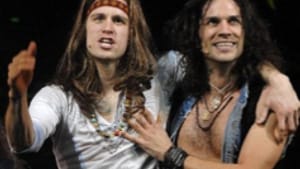Stay in the Loop
BSR publishes on a weekly schedule, with an email newsletter every Wednesday and Thursday morning. There’s no paywall, and subscribing is always free.
Radical for the '60s, passé for 2012?
"Hair' revival at Academy of Music

The current Philadelphia revival of Hair is almost the end of the road for this '60s hippie celebration. The national company ends its existence January 29 after stops in West Palm Beach and Cleveland.
That's a shame, because the production is excellent and its social relevance is even stronger now than when the revival opened on Broadway in 2009. There was no Occupy movement then; now citizens are demonstrating as they rarely have since the Vietnam War era, which was what Hair is all about. The kids in the cast resemble today's demonstrators, reflecting what co-author James Rado said in 1967: "This is happening in the streets and we wanted to bring it to the stage."
The staging is more colorful than the 1968 Broadway production, and so is the orchestration: the on-stage band includes an especially strong brass section. The cast is effective, and the leading man ("Berger") is particularly well played by Steel Burkhardt. Director Diane Paulus enhances the audience involvement by sending him into the house to ruffle patrons' hair and act as a master of ceremonies.
This revival has a more somber second act than the 1960s original and subsequent revivals. The induction into the army of one of the leading characters, and his death, were always in the script, but the new staging emphasizes the killing. The story comes to a chilling end rather than a triumphant one.
Songs like "Let the Sun Shine In," "Good Morning, Starshine," "Aquarius" and the infectious title tune, "Hair," became popular in the late "'60s and remain welcome friends now. Galt McDermot's music is catchy, and the lyrics by James Rado and Gerome Ragni, who co-starred in the original production, are vivid. The costumes and scenery evoke the Vietnam era.
So why is Hair closing? This production enjoyed a respectable run on Broadway, failed in London (unlike the 1968 original, which ran five years there) and has known only mixed success on the road.
Hair was always more than the sum of its parts. Its story is flimsy and its characterizations shallow. Its looseness was intentional: Many changes were made during the run, almost as if the whole thing was an improvisation.
The net effect is that Hair is remembered above all as a radical uprising on stage, a declaration of protest by the powerless: young people, non-whites and females. Its use of profanity as well as a non-erotic nude scene was considered so scandalous back in 1967 that producers like the Shuberts and Nederlanders refused to produce it. Today they might pass it up for the opposite reason: because profanity and nudity are passé.
That's a shame, because the production is excellent and its social relevance is even stronger now than when the revival opened on Broadway in 2009. There was no Occupy movement then; now citizens are demonstrating as they rarely have since the Vietnam War era, which was what Hair is all about. The kids in the cast resemble today's demonstrators, reflecting what co-author James Rado said in 1967: "This is happening in the streets and we wanted to bring it to the stage."
The staging is more colorful than the 1968 Broadway production, and so is the orchestration: the on-stage band includes an especially strong brass section. The cast is effective, and the leading man ("Berger") is particularly well played by Steel Burkhardt. Director Diane Paulus enhances the audience involvement by sending him into the house to ruffle patrons' hair and act as a master of ceremonies.
This revival has a more somber second act than the 1960s original and subsequent revivals. The induction into the army of one of the leading characters, and his death, were always in the script, but the new staging emphasizes the killing. The story comes to a chilling end rather than a triumphant one.
Songs like "Let the Sun Shine In," "Good Morning, Starshine," "Aquarius" and the infectious title tune, "Hair," became popular in the late "'60s and remain welcome friends now. Galt McDermot's music is catchy, and the lyrics by James Rado and Gerome Ragni, who co-starred in the original production, are vivid. The costumes and scenery evoke the Vietnam era.
So why is Hair closing? This production enjoyed a respectable run on Broadway, failed in London (unlike the 1968 original, which ran five years there) and has known only mixed success on the road.
Hair was always more than the sum of its parts. Its story is flimsy and its characterizations shallow. Its looseness was intentional: Many changes were made during the run, almost as if the whole thing was an improvisation.
The net effect is that Hair is remembered above all as a radical uprising on stage, a declaration of protest by the powerless: young people, non-whites and females. Its use of profanity as well as a non-erotic nude scene was considered so scandalous back in 1967 that producers like the Shuberts and Nederlanders refused to produce it. Today they might pass it up for the opposite reason: because profanity and nudity are passé.
What, When, Where
Hair. Book and lyrics by James Rado and Gerome Ragni; music by Galt McDermot; directed by Diane Paulus. Through January 8, 2012 at Academy of Music, Broad and Locust St. (215) 893-1999 or www.kimmelcenter.org.
Sign up for our newsletter
All of the week's new articles, all in one place. Sign up for the free weekly BSR newsletters, and don't miss a conversation.

 Steve Cohen
Steve Cohen